Giochi dell'Oca e di percorso
(by Luigi Ciompi & Adrian Seville)
(by Luigi Ciompi & Adrian Seville)

|
Giochi dell'Oca e di percorso
(by Luigi Ciompi & Adrian Seville) |

|
 |

Torna alla ricerca giochi (back to game search) |
 |
| Grand (Le) Terme ou le Jeu des Temps - Zeitlichkeit und Ewigkeit | ||
 |
Versione stampabile
 |
Invia una segnalazione

|
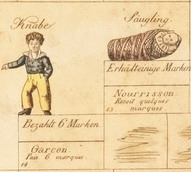     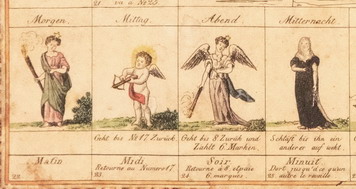 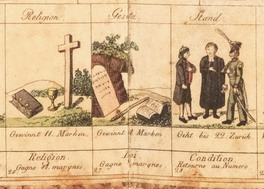 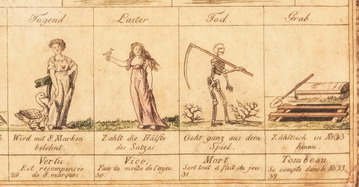 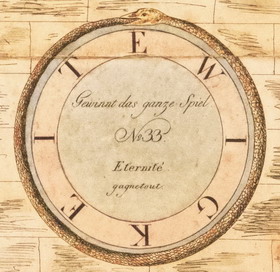  |
primo autore: | Anonimo |
| secondo autore: | Anonimo | |
| anno: | 1800/30 | |
| luogo: |
Germania |
|
| periodo: | XIX secolo (2°/4) | |
| percorso: | Percorso di 33 caselle numerate | |
| materiale: | carta incollata su tela (engraving on paper with linen backing) | |
| dimensioni: | 330X390 | |
| stampa: | Acquaforte (taille-douce) (ecthing) | |
| luogo acquisto: | ||
| data acquisto: | ||
| dimensioni confezione: | ||
| numero caselle: | 33 | |
| categoria: | Vita umana, attualità, lavoro e tempo libero | |
| tipo di gioco: | Gioco con i dadi | |
| editore: | Non indicato | |
| stampatore: | Non indicato | |
| proprietario: | Collezione L. Ciompi | |
| autore delle foto: | L. Ciompi (da "Goodfellow C.) | |
| numero di catalogo: | 1366 | |
| descrizione: |
Gioco di percorso di 33 caselle numerate che rappresenta la vita umana. REGOLE: sul tavoliere. CASELLE: con didascalia. Le Grand Terme ou le Jeu des Temps". (Victoria&Albert Museum). This is a Continental version of the Game of Human Life showing the ages of man. Its layout, however, is completely different from the earlier English and French editions. It was designed for the German and French market and uses only those two languages. The starting point is a clock face numbered 1 and entitled Temporellite or Zeirlichkeit and the finishing point is number 33, Eternity. Some of the squares require the receiving or paying of a token and some send the player forwards or backwards. The game would be played with dice and use a kitty. The player going out on the number 33 would win the kitty. Physical description Design: engraving, hand coloured mounted on card panels which fold out; with slipcase having a label showing 3 maidens dancing and title in German and French N°of squares: 33 Squares illustrated: some Square numbering: all Squares titled: all Subject of starting square: clock dial Subject of ending square: circled snake eating its tail Place of Origin: Germany Date: ca. 1825 Artist/maker: Unknown Materials and Techniques: Hand coloured paper on card Dimensions: Width: 15.5 in; height: 18.15 in Object history note This is the Game of Human Life showing the ages of man, however, the layout is completely different from the earlier English and French games. It was designed for the German and French market, English was not included. Historical context note Rewards: forward movement, receiving of counters Forfeits: backward movement, payment of counters N°of Players: any Equipment required: markers, counters and dice/teetotum Rules: The playing surface combines circles and squares, all numbered and some illustrated. The names and directions are in German and French and the game is played on the principles of forfeits and rewards. The starting point is a clock face numbered 1 and entitled TEMPORELLITE (ZEIRLICHKEIT); 2-Moments, 3-Secondes, 4-Minutes, 5-Heures, 6-Tours, 7-Semaines, 8-Mois, 9-Années, 10-Dixaines, 11-Siecles, 12-Millier dannées, 13-Nourrisson, 14-Garcon, 15-Fille, 16-Jeunehomme, 17-Vierge, 18-L'Homme, 19-Femme, 20-Viellard, 21-Matronne, 22-Matin, 23-Midi, 24-Soir, 25-Minuit, 26-Religion, 27-Lini, 28-Condition, 29-Vertu, 30-Vice, 31-Mort, 32-Tombeau, 33-Eternite (end). Numbers 13 to 32 have illustrations; numbers 2 to 12 are squares across the top of the board; numbers 13 to 21 are steps leading down from right to left; numbers 22 to 32 are squares at the bottom of the board. In the area beneath the `steps' are unnumbered squares painted pale pink each with a centre of black lines overpainted pale blue. The final number, 33, is a circle surround ed by a snake eating its tail. Some of the squares require the receiving or paying of a token; and some of the squares send the playing forwards or backwards. The game would be played with dice, use a kitty and the player going out with the number 33 would receive the kitty. Rules placement: directions printed on playing surface Descriptive line: Hand painted game, Le Grande Terme, published in Germany about 1825 REFERENZA 2 "Un deuxième jeu allemand, avec aussi un titre français, decrit toutes les époques de la vie d'un homme, il s'appelle "Le grand term ou Le jeu des temps"; il s'agit d'une gravure à l'eau-forte rehaussée à la main, publiée aux alentours de 1830. Les titres sont seulement en français et en allemand. Il se joue cependant de la meme manière que les autres, avec des récompenses et de pénalités, et une cagnotte centrale." (GOODFELLOW Caroline) REFERENZA 3 "A second German game, also with a French title and also showing the ages of man, was Le Grand "Terme ou Le Jeu des temps" , a hand-coloured etching published in about 1830. This has a completely different format from the others, and the titles are in French and German only. However, it is played in the same manner, with forfeits and rewards and a central kitty." (GOODFELLOW Caroline) REFERENZA 4 Zeitlichkeit und Ewigkeit Deutschland, um 1800 Kupferstich, handkoloriert, 33x39 cm Sammlung: Stadtmuseum Halle/ Saale (Inv. - Nr.: StM DX 518) Das grosse Ziel ist die Ewigkeit. Sie ist rund wie das Zifferblatt der Zeitlichkeit, ihr Gegenstueck und Endpunkt des Spiels. Der Spieler durchlaeuft unterschiedliche Lebensabschnitte, aehnlich wie im englischen New Game of Human Life (vgl. Spiel 54), die Grafik ist jedoch voellig unterschiedlich. Perfekt passt sich im Startfeld "Zeitlichkeit" das 12-stellige Wort in das Zifferblatt ein, am Endpunkt umrankt die Schlange, die sich selbst verschlingt und weder Ende noch Anfang kennt, den Wortkreis "Ewigkeit". Der Parcours des Spiels verlaeuft in einer sehr ungewoehnlichen Z-Form. Am oberen, abstrakten Balken (2-12) sind die Felder den Zeitraeumen unterschiedlichster Dimensionen gewidmet, die Temporalia im Wortsinn reichen vom "Augenblick" bis zum "Jahrtausend" und scheinen auf die ldee der Vergaenglichkeit des Lebens einzustimmen. Das sich anschliessende, illustrierte Leben (13-21) ist ein steter Abstieg von rechts oben nach links unten. Der Lebens-anfang ("Saeugling") ist geschlechtsneutral, danach sind - keine Selbstverstaendlichkeit in Spielen aus dem 19. Jahrhundert - vier Felder jeweils den alternden Maennern und vier den Frauen gewidmet. Die Einteilung entspricht der fuenfteiligen Skala der Lebensstufen bei Augustinus (infans, puer, adulescens, juvenis, senex). Der letzte Teil des Spiels (22-33) versammelt eine eher opake, fast beliebige Themenfuelle, sie fuehrt von den Tages - und Nachtzeiten zu Laster und Tugend, Grab und Tod, bis der Eintritt in die Ewigkeit geschafft wird. Blassblaue Schraffuren auf den Feldern an der Unterseite der Lebensalter strukturieren die rechte Haelfte des Spielplanes. Zeitlichkeit und Ewigkeit wirkt thematisch wie grafisch sprunghaft und in vielem wenig kohaerent, die Sequenzen muten assoziativ, ja improvisiert an; diese Attribute einem Spiel allerdings als negativ anzulasten, hiesse die Aesthetik des Spiels und die Funktion der Spiele im Alltag der Menschen gruendlich misszuverstehen. Je mehr man versucht, sie als etwas Geistiges zu erhoehen und dem systematischen Denken anzugliedern, desto mehr tut man ihnen unrecht und erniedrigt sie. Spiele sind weder Wissenschaft noch Kunst, sondern Teil der Popularkultur und gehoeren dem profanen Raum der Menschen an. Alle Regeln finden auf dem Spielplan Platz, gespielt wurde mit Wuerfel oder "Teetotum" (Drehkreisel), zu Beginn wurde ein bestimmter Einsatz in die Kassa gezahlt, die am Ende als Ganzes dem Sieger zufiel. (Ernst Strouhal) |
|
| bibliografia: |
1) GOODFELLOW, Caroline: "Jeux de société. Le guide du collectionneur des jeux de société depuis le XVIIIe siècle jusqu’à nos jours", (Edizione francese) Carrousel MS, 2001. 2) GOODFELLOW, Caroline: "A Collector's Guide to Games and Puzzles" Secaucus, New Jersey, Chartwell Books-London, Quintet Publishing Limited 1991. 3) GOODFELLOW, Caroline: "The Development of the English Board Game, 1770-1850", in Board Games Studies 1, 1998. 4) STROUHAL, Ernst: "Die Welt im Spiel. Atlas der spielbaren Landkarten”. Christian Brandstaetter Verlag. Universitat fur Angewandte Kunst, Wien. 2015 |
|
| "The Development of the English Board Game", 1770-1850 (Caroline G. Goodfellow) | ||
Vai alla ricerca giochi Vai all'elenco autori